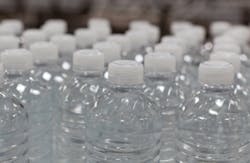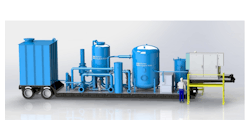In today’s on-the-go society, most of what we drink comes in a package. Increasingly, consumers are choosing bottled water more often and they are doing so for many reasons, including its refreshing taste, healthfulness, reliable quality, zero calories and additives, convenience, safety and value. In fact, since 1998, approximately 73 percent of the growth in bottled water consumption has come from people switching from carbonated soft drinks, juices and milk to bottled water. In addition, research shows that if bottled water isn’t available, 63 percent of people will choose soda or another sugared drink and not unfiltered tap water.
Consumers are choosing bottled water more often
Consumer preference for bottled water is only going to accelerate. Building on 2013’s growth, bottled water will again post significant increases in both sales and consumption for 2014, according to preliminary data from the Beverage Marketing Corporation (BMC). Even as other beverages struggle to gain or maintain market share, bottled water is expected to have had a 7.4 percent increase in consumption in 2014, which equates to 10.9 billion gallons. According to BMC, every segment of the bottled water industry is growing. Indeed, single-serve PET plastic bottled water (typically 16.9 ounces/half-liter) outperformed all other beverage categories, posting an increase of 8.4 percent.
Sales of bottled water in 2014 are expected to equate to around $13 billion (wholesale dollars), an increase of 6.1 percent from 2013.
Reflecting this clear trend of consumers increasingly choosing bottled water, BMC reported that over the past five years alone, bottled water has increased its share of the overall beverage market from 14.4 percent in 2009, to 17.8 percent in 2014.
With 20.9 percent, carbonated soft drinks currently hold the number one position. However, BMC now predicts that by 2016 bottled water will be the number one packaged beverage sold in the U.S.
The reason is simple: Americans are drinking more bottled water more often. Between 1976 and 2013, bottled water grew at a compounded annual growth rate of 9.5 percent, outdistancing every other beverage category. On a per capita basis, in 1976 every American drank 1.6 gallons of bottled water. In 2014 that figure is projected to have reached a record 34.2 gallons.
Consumers are already speaking with their wallets. BMC finds that bottled water already outsells soft drinks in 17 major cities, including New York, Boston, Los Angeles, San Francisco, Las Vegas, Houston, Miami and Washington, D.C.
Our industry has a strong, positive and forward-thinking story to tell. Bottled water companies use a very small amount of water when measured against almost any other industry, are dedicated to responsibly protecting and preserving our vital water resources and help people live healthier lives. And, bottled water consumption and sales growth in the U.S. in 2013 reflected the continuing trend of more Americans choosing to drink water more often.
Small environmental footprint
Even with this continuing growth and increased consumption, bottled water still has the smallest water and energy use footprint of any packaged beverage. The results of a recent IBWA benchmarking study show that the amount of water and energy used to produce bottled water products in North America is less than all other types of packaged beverages. On average, only 1.32 liters of water (including the liter of water consumed) and 0.24 mega joules of energy are used to produce one liter of finished bottled water, including home and office delivery (HOD).
The bottled water industry has a long and deeply-held tradition of effectively and responsibly protecting and managing our vital natural resources. Sustainable, protected and naturally recharged water sources are the single most important aspect of our business.
Focusing on FSMA
Implementation of the federal Food Safety Modernization Act (FSMA) continues to be a central issue for IBWA. IBWA remains heavily involved in the process to see FSMA fully operational, including submitting comments on all relevant U.S. Food and Drug Administration (FDA) proposed rules. We provided members several ways to receive FSMA updates and prepare for compliance with the new requirements, including educational sessions held during IBWA meetings and at state and regional association conferences and through IBWA’s publications, such as News Splash and Bottled Water Reporter magazine.
Defending BPA
IBWA continues to defend the safety of BPA. In 2014, over 80 bills in 22 states addressed the issue of the use of BPA in various consumer products and several bills were introduced in Congress to ban BPA in all food products. Working with our allies, IBWA ensured that no BPA legislation was adopted during the past year that would negatively impact the bottled water industry.
Bottled water’s active legislative and regulatory agenda
Bottled water in the U.S. is comprehensively regulated by the FDA as a packaged food product. By federal law, the FDA regulations governing the safety and quality of bottled water must be at least as stringent as U.S. Environmental Protection Agency (EPA) standards that govern tap water. And, in some very important cases, such as lead, coliform bacteria and E. coli, bottled water regulations are substantially more stringent.
In 2014, IBWA federal legislative action has been centrally focused on supporting the successful introduction of legislation to provide our consumers with transparency in bottled water quality reporting and labeling. IBWA applauded the introduction of the Bottled Water Quality Information Act, H.R. 4978. The landmark legislation with over a dozen co-sponsoring members of Congress is a bipartisan, IBWA-supported bill that will provide consumers with clear, consistent and comprehensive information about the quality and safety of their bottled water products.
Throughout 2014, IBWA monitored and commented on several drafts and introduced bills and reports dealing with bottled water labeling and quality, proposed bans on BPA in food containers, FDA funding and food facility user fees and water infrastructure; and IBWA is redoubling efforts to support congressional concerns being raised regarding the ban of the sale of bottled water in our National Park System.
Top issue areas for the bottled water industry in the states and localities during 2014 were taxes, groundwater and product bans. The industry was successful in disputing proposed bottled water tax initiatives in Washington and Vermont — two states where this issue is regularly on the agenda. Late in the year, and because of continued concern over drought issues in the western U.S., California passed major groundwater legislation. Although a final determination on the impact of these proposals has yet to be determined, it may benefit the bottled water industry in the long term as the state gives authority to municipalities to regulate groundwater use. Finally, local communities continue to discuss potential bans of single-serve plastic water bottles. In 2014, an ordinance was approved in San Francisco while Washington, D.C., and Cambridge, Massachusetts, are still considering possible proposals.
What’s on the horizon for 2015?
As we look to 2015 at both the federal and state levels, much hinges on what will happen in the upcoming election and how that may change Congress and the statehouses. Implementation of FSMA will also remain high on our agenda.
On the state level, we will focus on the monitoring and regulation of groundwater use, increased activity surrounding recycling and product stewardship issues, taxes on bottled water sales and water extraction, as well as additional talk around single-use product bans. With all 50 states in session in 2015, and an expected increase in new faces, it will be important for us to continue to educate lawmakers and regulators about our industry’s positive role in the lives of all Americans.
IBWA supports “Drink Up” and encourages consumers to drink more water
IBWA is proud to be an active supporter of Drink Up, an initiative of first lady Michelle Obama and the Partnership for a Healthier America (PHA), which encourages Americans to drink more water more often — whether from the tap, a filter or in a bottle. The effort has been so successful that a 2014 Nielsen Catalina Solutions (NCS) report shows Drink Up’s online ad campaign resulted in a three percent lift in sales among those who saw the advertising. This generated almost $1 million in incremental retail bottled water sales. IBWA has long promoted the many benefits of drinking water and the NCS findings confirm that the Drink Up partnership is an important and healthful effort that can benefit all Americans.
The bottled water industry has a great story tell. Drinking zero-calorie beverages, such as water, instead of sugary drinks is regularly cited as a key component of a more healthful lifestyle and efforts to reduce the prevalence of obesity in adults and children. According to the Institute of Medicine and the American Journal of Preventive Medicine, one-third of the American adult population is overweight and another one-third is obese. And, over the last 30 years, children’s obesity rates have climbed from five percent to 17 percent. Promoting greater consumption of water from all sources, including bottled water, will support the efforts of consumers striving for a healthier lifestyle.
Looking to 2015, we will continue to work hard to create a favorable business and legislative, regulatory and public affairs climate for the bottled water industry, as well as to protect and advance the interests of all IBWA member companies.
Chris Hogan is the vice president of communications for the International Bottled Water Association. Previously, he was with the American Gas Association, first as the director of investor relations and then as its director of communications. Chris holds an MBA and Master of International Management from the University of Maryland University College and a Bachelor of Science in political science from Northeastern University. Chris also holds the IOM association and nonprofit executive certification.


